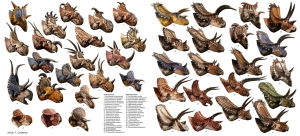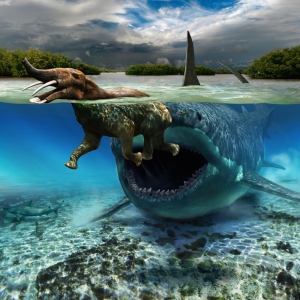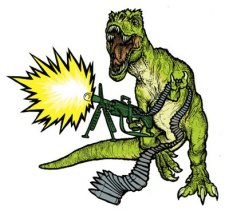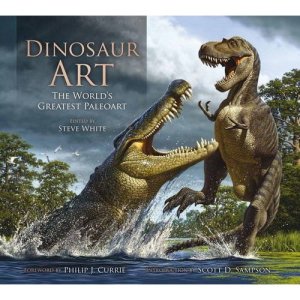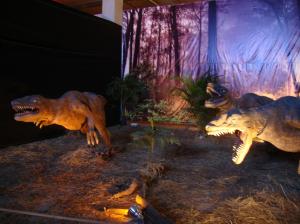by Carlos Augusto Chamarelli
Finally, our very first true paleoart post! Long overdue since the creation of this blog. Actually it looks more of a ranting post, but… Here I present my personal opinions of what is wrong with modern paleoart as well as giving some tips to make it right. See, everywhere I look for paleoartistic tips (from professionals, no less) they are pretty much the same, and not helpful at all. That is, from the ones I came across, but maybe some good soul out there give true helpful tips.
As an enthusiast of prehistoric life, I often see myself dissatisfied with the majority of modern reconstructions for extinct animals, and dinosaurs are understandably the prime victims of being portrayed as barely living things. And that doesn’t have anything to do with this “well, see, dinosaurs and other prehistoric animals were unlike anything alive today, so they must have been really weird!” BS. True, they are different from today animals, but that doesn’t mean they are complete aliens.
So here I present some of my critics about what’s wrong with modern depictions of prehistoric life and personal tips to what can be made to improve it.
– Don’t steal it!
The most banal but useful of all tips. Maybe it’s some kind of rite of passage to copy the works of other, usually more famous paleoartists; it’s only natural since copying can give useful insight of how to develop your own style and make your own pictures later, but that’s about what it’s good for: studying.
If you downright steal someone else work, even if you try to alter a little, people WILL find out, specially the keen eyed who had seen tons of paleoartistc pictures.
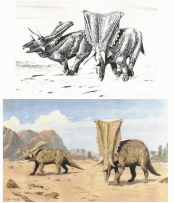
Top- Robert Bakker, 1971.
Bottom- Zdenek Burian, 1976.

Left- James Gurney, 90’s?
Right- John Sibbick, 1985.

Top Left- Chris Butler, 1991.
Top Right- Mark Hallett, 1990.
Bottom Left- Chris Butler, 1991?.
Bottom Right- Whoever did the dinosaurs in The Macmillan Illustrated Encyclopedia of Dinosaurs and Prehistoric Animals, 1988.
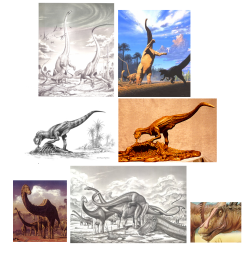
Top Left- Fabio Pastori, 2008.
Top Right- John Gurche, 80-90’s?.
Center Left- Fabio Pastori, 2009.
Center Right- Tony McVey, 90’s?.
Bottom Left- Mark Hallet, 1994.
Bottom Center- Fabio Pastori, 2008.
Bottom Right- Luis Rey, 90’s?.
Shame on that Pastori guy. Damn.
Previously this sort of stealing wasn’t so much a taboo for paleoart. Zdenek Burian for example, had to rely heavely in references others brought to him, so I can understand that he didn’t had much to work with when he made the Chasmosaurus painting back when there was no fancy internet and search engines. Still, even if it was out of necessity, it still sort of detracts the essence of the resulting work because it causes this déjà vu feeling.
Nowadays this problem is lessened because references are one google away, so anything that have remains other than teeth and isolated vertebrae should give a good idea as to what must be done. Still resorting to plagiarize someone else only says you’re slacking. Of course, I let one-time ocurrences to pass for certain artists. *
The extremely-obscure-where-it-wasn’t-released collection “Descobrindo o Mundo dos Dinossauros” (Discovering the World of Dinosaurs, translating the portuguese version. Originality at its peak) by the spanish publisher Salvat during the 2000’s is the greatest example of overstealing: the entire series is composed of a seemingly unending stealpalooza, the main victims being John Sibbick and Jurassic Park’s concept artist Mark “Crash” McCreey. There are just so many obviously stolen pictures in all the 40 issues I can’t just point them all out, so I’ll just leave one where they did abstolutely nothing to try covering it up. And that’s not even the worst part: the larger one is suposed to be an Argentinosaurus.
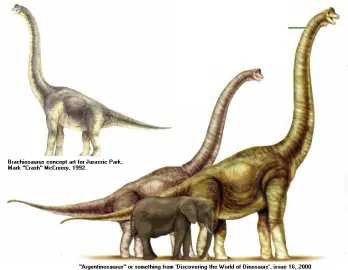
Quality!
Also on the same note, please, PLEASE don’t use this picture of Turok for ANYTHING.
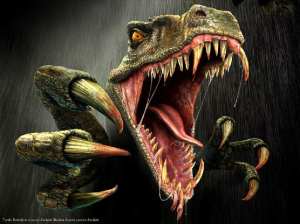
Attack of the were-o-saurus!
I lost count of places I’ve seen this thing already.
– Flesh it properly!
The single most glaring and common gaffe of a paleoartist is taking the skeleton reference a little too literal, resulting in a creature that looks little more than a skeleton with a thin layer of skin over it. Bonus points if said creature have huge, bulging leg muscles.
One such artist known for this is Gregory S. Paul. If you’re into paleoart or dinosaurs in general you must have seen his work around. Honestly, I don’t care much about him. I know there have been some discussion about him lately, I’m not exactly sure about what, but seems to be about his skeletal reconstructions and a rather harsh commentary about other paleoartists, but I’m not going there. The real issue with GSP and people who adopted a similar style is how the animal looks like a starved walking corpse: the skull fenestrae, the vertebrae, the hips, the shoulder blades… They’re all there!
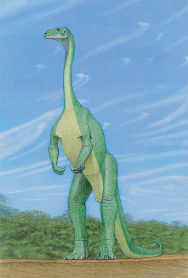
Plateosaurus longiceps, by Gregory S. Paul.
I mean, Ok, I get it, you used skeletal reference. That’s nice, but can you feed the poor animal now? Doing this only deprives your picture from conveying any life. If you look at any dinosaur analog you like, be it bird, reptile or even mammal, you’ll see they have a relatively “smooth” appearance- that is, if you remove the feather/fur coating. Their bones are visible only at certain parts of their bodies, and even then those are not entirely visible.

Featherless chicken breed. Taken from newscientist.com.
Don’t worry, he’s not sick and nobody pulled his feathers: this special breed combines the gene of other breeds who naturally lack feathers in certain parts of their bodies. Some argue that the lack of feathers make them vulnerable to sunburns and parasites, other says the lack of feathers is an advantage, but the point I’m trying to make is that despite the seemingly unnatural appearance, the skeleton is not visible, and muscles are balanced. I mean, the legs surely are muscular, but they look nothing like some of the monstrosities on steroids you often risk coming across when looking at dinosaur pictures.

Daspletosaurus, by an unknown artist, made somewhere around the 2000’s I think. I have no idea who the artist is, but I simply abhor his work.
Of course, that doesn’t mean that I absolutely hate everything by GSP. For one I’m especially fond of this Yangchuanosaurus picture, despite some gaffes like the visible fenestrae:
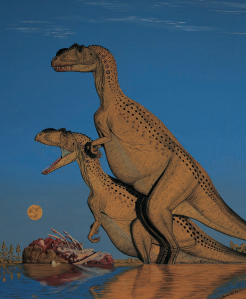
Yangchuanosaurus shangyuensis, by Gregory S. Paul
Speaking of visible fenestrae, that’s a big no-no. Facial features are one of the key elements for paleoart, especially since some artists prefer to make portraits that focus on the animals head, so if you want to make a good dinosaur or any other prehistoric animal picture you should remember to make the creature having an appropriate face. Starting by not making fenestrae visible since that just doesn’t happen.
If Bakker teached me anything as a kid in Paleoworld, a true paleontology classic TV show from the 90’s (Dinosaur Revolution got NOTHING on this) is that the tiny holes you see along some animals skull around the mouth are the attachments for lips; having bigger holes near the eyes suggest that the animal in question is particularly lippy.

Green iguana and horse and their skulls, compared to Allosaurus and Diplodocus.
So taking the above example and comparing to those of dinosaurs, one can infer that the theropod Allosaurus had lizard lips (maybe even teeth-covering ones at that), while the sauropod Diplodocus had a face more similar to that of the horse, unlike the creepy, bare-toothed creature you see below…

Coming straight out of the ground is only mildy unsettling.
That’s also one of the few reasons why you rarely can go wrong when picturing prehistoric mammals: there’s plenty of analogs alive today, so you can use any of the closest related species or similar creatures as references…

All entelodontids pictures out there are variations of this one.
… Mostly. The above creature is a Archaeotherium, from a now-extinct family of omnivorous, pig-like creatures affectionally nicknamed “hell pigs”. Paleoartists have a particular penchant for making them as scary as possible, as you can see, their mouths are perpetually open, and seemingly devoid of lips. The rare occasions they are depicted with their mouths closed, they tend to show their teeth, ranging from just the upper canines to all of the front teeth… Except that if you just take a look at his skull and compare to his living close relatives – pigs and hippos- , you’ll figure it is supposed to have the same kind of fleshy muzzle these have.
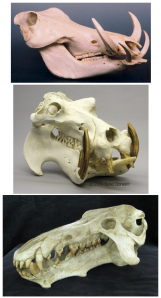
Warthog, hippo and Archaeotherium skulls. Just wonder if all we knew about hippos came from their fossils.
Oh, and ceratopsians are still the odd ones: they have both big and tiny lip attachments. What does that mean? I don’t know, but my best guess is that they had cheeks, but unlike the ones you commonly see around, they probably didn’t ended right at the beak margin.

Triceratops skull. Taken from brantworks.com.
That also remind me of someone who criticized the presence of “eyebrows” on dinosaurs in certain pictures because there’s “no evidence for this”… Are you kidding me? Have you never seen an eagle?

Bald eagle and the permanent frowning. Taken from nationalgeographic.com.
One of the main features of eagles and similar predatory birds: the mean look. This effect is created by a pair of bone knobs in front of each eye that sustain the skin that form the brow. This same structure is found in other birds as well as some modern reptiles and many dinosaurs, specially theropods, although there are non-theropods examples. Interestingly enough, in lizards the knobs are smaller, but even these are able to make sizeable eyebrows.

Bald eagle skull. Taken from skullsunlimited.com. Sure it’s just a replica, so what?
So if you have the skeletal reference but don’t consider what it looks like in modern living animals, you’ll have things like these models of Mei Long from the American Museum of Natural History… I wish I could grab a better picture, but if you look hard enough you’ll see he ended up with those silly knobs right in front of the eyes. He’s not the only one from the same exhibit to end up like that either.

Mei Long from the AMNH. Photo by Roderick Mickens, taken from dinosaurs.royalbcmuseum.bc.ca.
– ….But don’t be exaggerated!
On the opposite spectrum of the sickly, skeletal creatures from the likes of GSP are the overly fleshed ones. Sometimes, at the wrong places. This happen when the artist want to make a creature more “interesting” and draws “inspiration” from living animals who sport such details, specially reptiles and exotic birds.
One such artist is the dreaded and sometimes loved (but not here, go away) Todd Marshall. The problem with his pictures is that he knows no restraint: all of his dinosaurs have huge serrated dewlaps and are covered in spikes everywhere.

Spinosaurus aegypticus by Todd Marshall. Alternatively, it could bethe devil himself. At least the sail is immaculate in this one…
Now, there’s nothing inherently wrong with adding details such as these. Heck, we do have evidence that Diplodocus and Ceratosaurus had a row of spikes along their backs, Carnotaurus had parallel rows of nodules and skin impressions in Edmontosaurus show he had a considerable-sized dewlap. But it couldn’t hurt to know when it’s appropriated and when it’s over the top.
Okay, so you have the (male) green iguana (Iguana iguana), and he has a row of spikes along the back and a big dewlap which too have some edgy scales. So while it may seem acceptable to recreate this aspect for dinosaurs and other prehistoric creatures, one should consider these characteristics are not as common as they seem. The serrated dewlap and spiked back are more specific to the iguana genus; most lizards don’t have any of these details, some have a ridge along the back, some have dewlaps. But very few have both. Heck, that’s not even universal for other iguana species. The marine iguanas (Amblyrhynchus cristatus), for example, have a row of spikes in their backs, but with smaller spikes and they have no dewlap, while the rhinoceros iguana (Cyclura cornuta) too have no dewlap and even smaller spikes in the back.

Green, marine and rhinoceros iguanas.
So basically what i’m saying is that it’s perfectly fine to add details, but you should do so sparingly, sometimes creatures don’t have any. If you recreate every single creature with as many details you can fit, instead of a mesozoic scene you have Pandora from Avatar.

Psittacosaurus skeleton, taken from wikipedia. Take a look at the ROW of quills at the TAIL.
Another problem with exaggeration is when you have the evidence for a detail, but decide to amplify it, sometimes to less than realistic proportions. One examples I can cite is the Psitaccosaurus. As most might know by now, he had a row of quills in their tails, as you can see in the above picture.

Psittacosaurus by Heather “Kyoht” Baeder.
…So where does one take this from?!
Anyway, for now those are the tips I have to give, but more will be posted eventually. I hope these were helpful enough for all of you who want to get into paleoart as business or just as a hobby.
Thanks for reading!
For more about paleoart, you might want to see:
*I edited out Sergey’s mention since he himself cleared his case in the comments. If any other artist don’t wish to have their work pictured here, feel free to say so.


